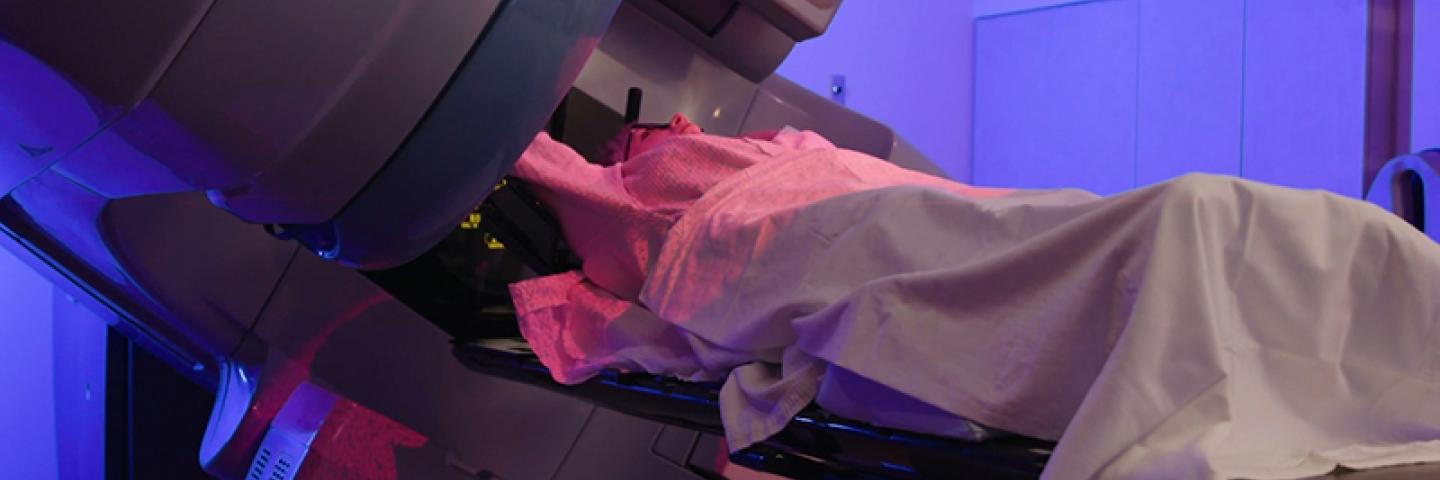Microsite Admin Fields: Regional Cancer Center

Radiation Oncology
Hunterdon Regional Cancer Center utilizes state-of-the-art radiation therapy technology coupled with individualized and compassionate care close to home.
For more information, please call (908) 788-6547.
Types of Radiation Therapy Treatments
- Intensity-Modulated Radiation Therapy (IMRT):
IMRT utilizes advanced planning software to deliver a more precise radiation treatment plan while decreasing potentially harmful doses to surrounding tissue. - Volumetric Modulated Arc Radiotherapy (VMAT):
VMAT uses IMRT technique but delivers the radiation while the machine rotates around the patient. VMAT enables the treatment times to be drastically reduced even more from a standard IMRT treatment. - 3D Conformal:
3D conformal radiation shapes the radiation beam around the shape of the tumor or area to be treated with photon radiation. - Electrons:
Electron beam therapy is a more superficial type of radiation. It does not travel far into the body and is typically utilized for skin treatments or for tumors close to the skin surface. - Stereotactic Body Radiation Therapy (SBRT):
SBRT administers very high doses of radiation to small tumors. Due to the high doses, it is typically delivered within five treatment visits. - Surface Guided Radiation Therapy (SGRT):
Hunterdon Regional Cancer Center utilizes cutting-edge technology to provide skin surface tracking (SGRT) to our patients. SGRT improves the accuracy and speed of patient setups and can reduce repeat imaging necessary for positioning. It allows real-time motion management and is used in deep breath hold techniques. See www.visionrt.com for more information.
- High-Dose Rate Brachytherapy (HDR):
HDR is a type of internal radiotherapy. A series of radiation pellets travel to the treatment site via temporary catheters for a few minutes and then retract back into the machine. The benefits are more focused radiation treatment areas, fewer side effects, and shorter treatment visits. HDR is currently offered at Hunterdon Regional Cancer Center for skin cancer, breast cancer, and gynecological cancers. - Low-Dose Brachytherapy:
Hunterdon Regional Cancer Center can provide low-dose brachytherapy for the treatment of prostate cancer. It is also known as brachytherapy seed implantation or interstitial radiation therapy. This procedure uses small radioactive seeds and places them directly in the prostate where they will remain. The seeds can give off the desired amount of radiation to a small area, such as a prostate, and eliminates the need to come in for external beam radiation treatment for 9 weeks.
- Prone Breast Irradiation:
At Hunterdon Regional Cancer Center you can discuss with your physician whether prone breast irradiation is right for you. Research has found that positioning some women with breast cancer in the prone or face down position when they receive radiation therapy, minimizes the risk of damage to the heart, lungs and surrounding structures. - Deep Inspiration Breath Hold:
For left-sided breast cancer, deep inspiration breath hold (DIBH) may be an option for you to decrease the radiation dose delivered to the heart. By only radiating the breast tissue when a breath is taken in and held for approximately 23-30 seconds, it moves the heart father away from the area being treated and reduces the heart and lung dose. - Hypofractionated Radiation Therapy:
Patients treated with hypofractionated radiation therapy receive a larger dose of radiation across fewer treatment sessions, allowing them to complete treatment in three to four weeks, compared with five to seven weeks for conventional radiation therapy treatment. Decisions regarding whether to treat a patient with hypofractionated radiation therapy or conventional therapy are individualized and should be discussed with your Radiation Oncologist. - Accelerated Partial Breast Irradiation (APBI):
With APBI treatments, the radiation is focused specifically in the tumor bed cavity (where the tumor was removed) via a temporary catheter and High Dose Brachytherapy. The radiation is concentrated to the site of the lumpectomy and greatly reduces your treatment schedule from six to seven weeks to twice a day for five days. APBI is not appropriate for all patients; we encourage you to discuss with your Breast Surgeon and Radiation Oncologist.
- SpaceOar Hydrogel:
When using SpaceOar Hydrogel in conjunction with your prostate cancer radiation treatment, it can greatly minimize the radiation dose to the rectum and can reduce urinary, sexual, and bowel side effects. The hydrogel is inserted between the prostate and the rectum and can provide about a ½ inch of extra space enabling the radiation to fully treat the prostate without impacting the rectum. After radiation treatment, the hydrogel completely absorbs. Please see www.spaceoar.com for more information.